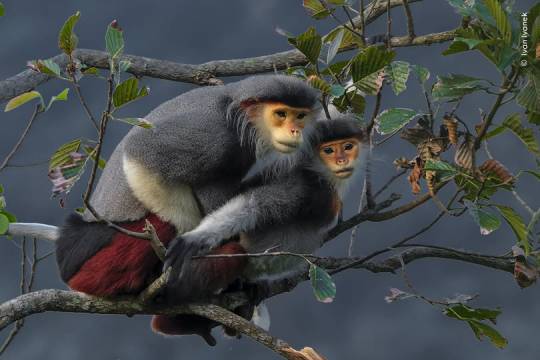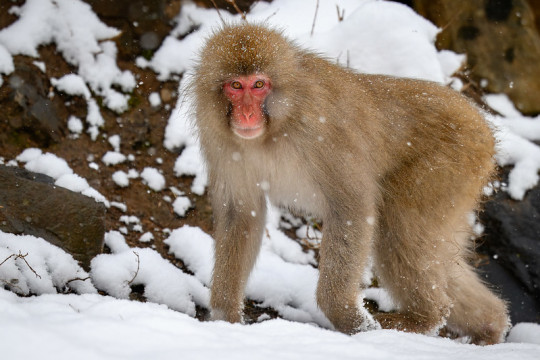#Cercopithecidae
Explore tagged Tumblr posts
Text


White-headed Langur (Trachypithecus leucocephalus), family Cercopithecidae, endemic to Guangxi, China
CRITICALLY ENDANGERED.
Photograph by VCG via: China Plus Culture
1K notes
·
View notes
Text

A dusky leaf monkey (Trachypithecus obscurus) and its infant in Malaysia. Infants of this species are born orange/blonde, which fades as they age
by K.L. Chew
#dusky leaf monkey#juvenile#langurs#monkeys#trachypithecus obscurus#trachypithecus#cercopithecidae#simiiformes#haplorhini#primates#mammalia#chordata#wildlife: malaysia#wildlife: asia
290 notes
·
View notes
Text
Spectember 2024 #04: Forest Gelada
Someone who identified themself only as Pendrew asked for a "ruminant-like Old World Monkey":

After much of East Africa rifted off into a separate continent, shifting climate turned the alpine grasslands of what was once the Ethiopian Highlands into into warmer subtropical forests – and the highly terrestrial grass-eating geladas that inhabited the region adapted to new sources of food.
Yedenigelada pendrewsii is a large quadrupedal herbivorous monkey, about 1.5m tall at the shoulder (~5'). It has a specialized pseudoruminant digestive system with a three-chambered stomach, similar to that of camelids, and it occupies an ecological niche convergent with the ancient chalicotheres, selectively browsing on trees and shrubs while sitting upright and using its long clawed forelimbs to pull branches within reach.
Unlike its highly social ancestors this species is mostly solitary, although during the breeding season groups of males come together in leks to compete for female attention. Displays consist of inflating large colorful throat pouches to make loud resonating calls, and flipping upper lips to bare teeth and gums.

#spectember#spectember 2024#speculative evolution#gelada#cercopithecidae#old world monkey#primate#mammal#art#science illustration
210 notes
·
View notes
Text

Red-shanked Douc
150 notes
·
View notes
Note
Golden snub-nosed monkeys?:) Weirdly ethereal vibes I would say
They're very unique looking!


#endangered species#central china#golden snub nosed monkey#endangered animal#endangered animals#mammalia#mammal#mammals#primates#haplorhini#simiiformes#old world monkey#monkey#monkeys#cercopithecidae#animal polls#poll blog#my polls#animals#polls#tumblr polls
37 notes
·
View notes
Text


East Javan Langur (Trachypithecus auratus) - (c) Saritawolf - please do not repost
38 notes
·
View notes
Text

Japanese macaque
“Snow monkey in Yamanouchi, Nagano, Japan grooming and cleaning her young.” - via Wikimedia Commons
#snow monkey#japanese macaque#wikipedia#wikipedia pictures#nature#wikimedia commons#animals#monkey#japan#Nihonzaru#ニホンザル#macaque#Macaca fuscata#primates#haplorhini#simiiformes#Cercopithecidae#old world monkey#yamanouchi#nagano#animalia#zoology#mammalia#chordata#chordates
32 notes
·
View notes
Text
Uncharismatic Fact of the Day
Wolf's mona monkeys don't have to worry about their eyes being bigger than their stomach. Like chipmunks, they have large cheek pouches which can store an entire stomach's worth of food-- handy for fleeing predators mid-meal, or storing snacks for later!

(Image: A Wolf's mona monkey (Cercopithecus wolfi) by Helene Hoffman)
If you like what I do, consider leaving me a ko-fi!
64 notes
·
View notes
Text

Popa Langur by the New England Primate Conservancy
3 notes
·
View notes
Text

Japanese macaque (Snow monkey), Macaca fuscata According to a specialist, Karuizawa used to have large groups of monkeys in the downtown area, causing a lot of suffering. Currently, the coexistence of humans and monkeys is being sought through a variety of measures, including 24-hour surveillance. Some individuals have been fitted with transmitters, and the location of the group is announced to the town's residents every evening via the town's mailis.
ニホンザル 詳しい方によると、軽井沢ではかつて繁華街にも大群が出没し被害が大きかったが、現在は24時間体制の監視など様々な対策で人間との共存が模索されているとのこと。発信機がつけられた個体もいて、町のメーリスで群れの位置が町民へ毎夕周知されている。
Nagano Pref. 長野県 2024-05-11
#mammal#monkey#animal#wildlife#naturephoto#natorephotography#nature#japan#nagano#karuizawa#spring#may#Macaca#Cercopithecidae#Primates#snowmonkey
7 notes
·
View notes
Text




Barbary macaque (Macaca sylvanus), family Cercopithecidae (Old World monkeys)
Diet in the wild includes a large variety of plants and insects. They eat almost every part of a plant, including not only flowers, seeds, and leaves, but also bark, stems, roots, and even gum.
Ouwehands Dierenpark, taken June 2024
#animals#zoo#zoo photography#nature#Barbary macaque#Macaca sylvanus#cercopithecidae#old world monkeys#macaque#ouwehands dierenpark
5 notes
·
View notes
Text

Red-shanked Douc (Pygathrix nemaeus), family Cercopithecidae, Sơn Trà peninsula, Viet Nam
CRITICALLY ENDANGERED.
photograph by Ivan Ivanek
214 notes
·
View notes
Text

A Japanese macaque (Macaca fuscata) in Japan
by ted smith
#japanese macaque#macaques#monkeys#macaca fuscata#macaca#Cercopithecidae#Simiiformes#haplorhini#primates#mammalia#chordata#wildlife: japan#wildlife: asia
160 notes
·
View notes
Text
Spectember/Spectober 2024 #10: Nosey Sea Monkey & Louse Mouse
Okay, let's finish up this year's round of speculative evolution concepts with one last post before we get back to normal paleoart content.
(…what do you mean it's November 3rd? how did that happen?)
Belial Lyka asked for a "marine proboscis monkey with a somewhat buoyant nose":

A descendant of modern proboscis monkeys, Phusarhinus beliallykae is a large semiaquatic primate found in shallow marshy coastal areas of what was once Southeast Asia. Around 4m long (~13') it has a lifestyle somewhat similar to ancient early sirenians, feeding on soft aquatic plants and hauling out onto land to rest.
Its dense rib bones and long flipper-like grasping forelimbs make it rather front-heavy, allowing it to naturally float with its head and arms hanging down closer to the bottom for energy-efficient foraging. When it needs to resurface to breathe it shunts air from its lungs into its large inflatable nasal sacs, altering its buoyancy enough to tip its head back up towards the surface.
Unlike its ancestors the elaborate nasal structures are found on both males and females – although they're more brightly colored in males and are also used for visual courtship displays and as resonating chambers for loud booming calls.
———
And somebody who only gave their name as "bunny" suggested a "parasitic rodent":

Sanguichelonamys bunnyi is a highly unusual descendant of a rakali-like semiaquatic rodent that had a symbiotic relationship with early members of the Phusarhinus lineage. The rodents initially just removed algae and external parasites from the bodies of the increasingly bulky aquatic monkeys, but things have recently started to turn more parasitic.
At just 3cm long (~1.2") Sanguichelonamys is one of the smallest mammals to ever exist, with a wide flattened body and sharp hooked claws used to cling onto its host monkey's thick skin. Although it still does remove other parasites, during haul-out periods it will also use its sharp incisors to deliberately enlarge the wounds left behind – or even open up new ones – and directly feed on fresh blood from its host.
The thickened keratinous skin along its head and back has a specialized hydrophobic surface that traps a layer of air while underwater, acting as a "rebreather" bubble similar to that of water anoles. Along with the ability to drastically slow down its metabolism and respiration rate, this allows Sanguichelonamys to survive being submerged during its host's lengthy foraging dives.
#spectober#spectember#spectember 2024#speculative evolution#cercopithecidae#old world monkey#primate#muridae#rodent#mammal#art#science illustration#and thus nix escapes from spechell for another year#see you tomorrow with our regular schedule
170 notes
·
View notes
Text

East Javan Langur
#east javan langur#langur#Trachypithecus auratus#Primates#Haplorhini#Simiiformes#Cercopithecidae#Trachypithecus#upl
140 notes
·
View notes
Text

Colobus monkey and baby
#animal#picture#mammal#live animal#baby animal#monkey#colubus monkey#primate#cercopithecidae#old world monkey
2 notes
·
View notes